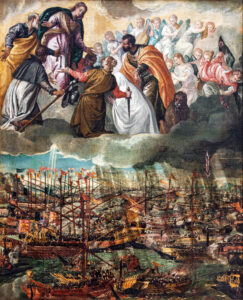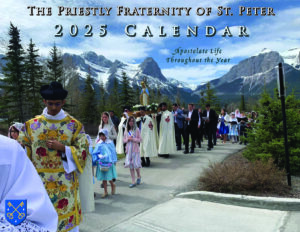There’s Something Fishy about that there Rosary
by Fr. William Rock, FSSP

On the first Sunday in October in 1571, the seventh day of the month, a Christian fleet, commanded by Don Juan of Austria, engaged a Turkish fleet in the Gulf of Lepanto. The resulting Christian victory – which preserved Christendom from a Turkish sea-invasion – was in large part due to the prayers of the Rosary Confraternities and the intervention of Our Lady. In commemoration, a feast was instituted, that of “Our Lady of Victory,” which was later renamed “Our Lady of the Rosary.” Because of the prominence of this feast, the entire month became dedicated to the Holy Rosary.
According to pious tradition, as recounted in the traditional Matins readings of the Third Nocturne for the Feast, the Rosary, in more or less its present form, was given to St. Dominic by Our Lady to combat and ultimately defeat the Albigensian heresy in southern France. As such, the connection between the Holy Rosary and victory over the enemies of the Church was established long before the battle at Lepanto.

The traditional core of the Rosary is composed of 150 Hail Marys. Because of this, it was known as Our Lady’s Psalter, the 150 Aves mirroring the 150 Psalms. These 150 Aves are then divided into three sets of five mysteries, the Joyful, Sorrowful, and Glorious, with ten Hail Marys being assigned to each mystery.
When Our Lady appeared at Fatima, she asked that a third of the Rosary be recited daily for peace, meaning 50 Hail Marys or one set of Mysteries. This is how many pray their daily Rosary, but a full Rosary has 153 Hail Marys in total, the above-mentioned 150 for the Mysteries and 3 which are introductory. It is worth noting that between May 13, 1917, the day of the first apparition at Fatima, and October 13, 1917, when the Virgin Mary presented herself as the Lady of the Rosary, there are, counting exclusively of the day of the first apparition, 153 days.

In his Fifth Method for Saying the Rosary, St. Louis de Montfort associates the 153 Hail Marys with the 153 fishes which were caught in John 21 when Our Lord appears to the Apostles as they are fishing on the Sea of Galilee. The saint expressed that the Rosary’s “fruitfulness [is] shown in the net that St. Peter by order of Our Lord threw into the sea and which though filled with 153 fish did not break.”1
Numerous interpretations have been given as to the meaning of the number of fishes caught. Cornelius à Lapide, in his commentary on the Gospel of John, summarizes them as follows:
S. Jerome gives (in Ezek. xlvii. 9) the literal reason; because there are just that number of different kinds of fish. This is what he says, “Those who have written about animated nature say that there are an hundred and fifty-three kinds of fish. One of each of these kinds was caught by the Apostle, and more remained uncaught. For noble and ignoble, rich and poor, all sorts and conditions of men, are drawn out of the sea of this world to salvation.” You must, however, understand the matter thus, that only the chief genera of fishes are included in this number, for, speaking strictly, there are many more kinds. Therefore by this number, or symbol, Christ signified that all nations were to be gathered up into the net of the Church, whose head and prince is Peter, and his successors, the Roman Pontiffs.
Symbolically, Cyril says the number one hundred signifies the fulness of the Gentiles which was about to enter into the net of Peter and the Church: the fifty signifies the smaller number of the Jews, who would be saved: the three represents the mystery of the Blessed Trinity, by the faith and worship of Whom both Jews and Gentiles are gathered together and saved. But S. Augustine (Tract. 122) says, “This number is made up of three times fifty plus three, because of the mystery of the Trinity. The fiftieth was the year of jubilee in which all the people rested from all their labours. The year of jubilee represented the state of Gospel grace.”
More particularly and plainly Rupertus and Maldonatus explain thus. By those three numbers is signified the three-fold race of men who are saved. The hundred denotes those who are married, “for these are the most numerous. The fifty denotes the widows and the continent, for these are fewer in number. The three denotes virgins, the fewest of all.”
So, 153 could represent all the nations of the world brought into the Church – or – 100, the Gentiles, 50 the Jews, and 3 the Holy Trinity – or – 3, the Trinity, and 50 thrice, the Year of Jubilee – or – 100, the married; 50, widows and the continent; and 3, the virgins. All are possible and non-contradictory interpretations.

St. Augustine also notes, as he is wont to do, in his Tract on the Gospel of John that 153 is the sum of the first 17 whole numbers, that is 1+2+3 and so on up to 17 which gives 153. 17 is, of course, 10+7, with 10 representing the Ten Commandments and 7 the Gifts of the Holy Spirit. Here 153 represents the combination of Grace and the Commandments and therefore all “who are sharers in such grace are symbolized by this number, that is, are symbolically represented.”2 So, 153 can represent all those who share in grace.
In recognizing that 153 is the sum of the first 17 whole numbers, St. Augustine recognizes 153 as what would be called by modern mathematicians a Triangular Number. These numbers can be visualized by using beads laid out to form a growing triangle. The number of beads which form a complete row of the growing triangle, and thus form a complete triangle themselves, and which count is also equal to the sum of the number of rows, are the Triangular Numbers (see accompanying image). The series of Triangular Numbers up to 153 are 1, 3, 6, 10, 15, 21, 28, 36, 45, 55, 66, 78, 91, 105, 120, 136, and 153. 153 is the 17th Triangular Number, meaning that the 153rd bead fully completes a triangle with 17 rows of beads.
Additionally, 153 is also a Hexagonal Number. These numbers can be visualized by beads forming growing nested hexagons all sharing the original bead as a corner point and each new hexagon having side lengths which are each one bead longer than the previous. Similar to Triangular Numbers, the number of beads which close each of the hexagons are the Hexagonal Numbers (see accompanying image). The series of Hexagonal Numbers up to 153 are 1, 6, 15, 28, 45, 66, 91, 120, and 153.

153 is also the sum of the first five positive factorials: 5! + 4! +3! + 2! + 1! = 5x4x3x2x1 + 4x3x2x1 + 3x2x1 + 2×1 + 1 = 120 + 24 + 6 +2 +1 = 153.
Further, 153 is a Narcissistic Number which is a number where the sum of the digits each raised to the total number of digits returns the original number. 153 has 3 total digits: 1, 5, and 3. The calculation of the Narcissistic Number is: 13 + 53 + 33 = 1 + 125 + 27 = 153.
Now, dear reader, you might be asking what is the importance of Triangular Numbers, Hexagonal Numbers, and Narcissistic Numbers? To be honest, I do not know, but they are important to mathematicians and, more importantly, reflect the order which God has built into the creation He designed.

In addition to its mathematical properties, 153 also has a curious association with the mandorla, the “almond-shaped aureole of light surrounding the entire figure of a holy person; it was used in Christian art usually for the figure of Christ.”3 The mandorla is also called the vesica piscis, or the “bladder of a fish.” The connection between this shape and the number 153 is explained as follows:
The number 153 is also sometimes said to be related to a symbol called the “vesica piscis”, which consists of the intersection of two equal circles whose centers are located on each other’s circumferences. However, the relevance of the number 153 to this shape is rather dubious. It rests on the fact that the ratio of the length to the width of this shape equals the square root of 3, and one of the convergents of the continued fraction for the square root of 3 happens to be 265/153. It is sometimes claimed that this was the value used by Archimedes, but this is only partly true. Archimedes knew that the square root of 3 is irrational, and he determined that its value lies between 265/153 and 1351/780, the latter being another convergent of the continued fraction.4

It should be noted that sideways, the vesica piscis resembles the shape of the body of the Christian Fish, the “Jesus Fish,” the ichthus, a symbol used in the early Church, now usually encountered on the back of cars. (N.B.: as the vesica piscis also has non-Christian and unedifying associations, a high degree of caution should be observed if one wishes to undertake further research, especially with regards to image searches).
Now, dear reader, if the above number treatment seems weird and foreign to the Christian approach to things, I can only encourage you to read more Augustine as he spends a great deal of time dealing with numbers in this manner.
The 153 Hail Marys of the full Rosary are filled with meaning. 153 could represent all the nations of the world brought into the Church – or – 100, the Gentiles, 50 the Jews, and 3 the Holy Trinity – or – 3, the Trinity, and 50 thrice, the Year of Jubilee – or – 100, the married; 50, widows and the continent; and 3, the virgins. 153 is also mathematically teeming as it is a Triangular Number, a Hexagonal Number, the sum of the first five positive factorials, a Narcissistic Number, and also associated with the shape of the almond-shaped glory cloud found in Christian art. These are all fitting and proper things to reflect upon during this month dedicated to the Holy Rosary. May these reflections, then, aid in keeping this month well.
Our Lady of Victory, Our Lady of the Holy Rosary, pray for us!
Fr. William Rock, FSSP was ordained in the fall of 2019 and is currently assigned to St. Stanislaus Parish in Nashua, NH.
In support of the causes of Blessed Maria Cristina, Queen, and Servant of God Francesco II, King
- Writings of St Louis Marie de Montfort – Methods for Saying the Rosary.
- St. Augustine’s Tract on the Gospel of John, 122, 8.
- Mandorla | Byzantine, Christian & Medieval | Britannica.
- Catch of the Day (153 Fishes) (archive.ph).
October 7, 2024









